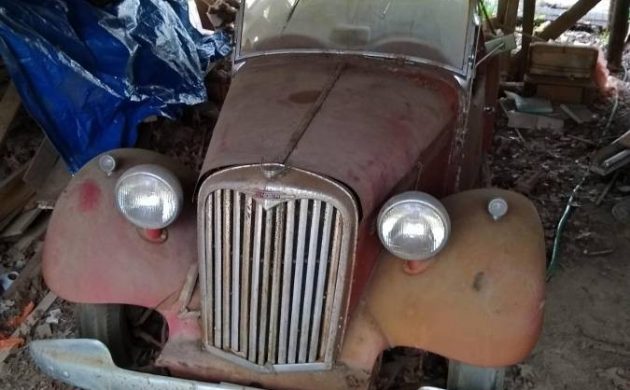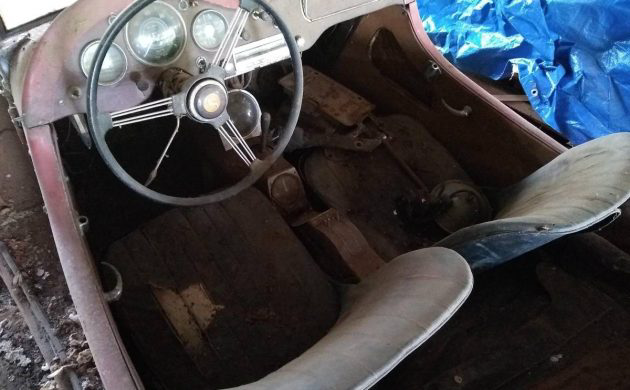Stored 50 Years: 1951 Singer 4AD Roadster
Usually, the Singers that come up for sale are the VW-based kit cars that no one is particularly crazy about. This, however, is a genuine 1951 Singer that has been in storage since the late 1960s/early 1970s. The car has also been with one family since that time and was driven and enjoyed regularly prior to being parked. It has a complete drivetrain from a Triumph TR3B swapped in, and you’ll find this barn-find Singer here on craigslist for $2,500. Thanks to Barn Finds reader Chuck for the find.
According to the listing, the seller is the son of the long-time owner, who amassed a collection of over 200 cars. The Singer was garaged until a few years ago, before being out to the carport. The listing notes the seller’s father was an aircraft engineer, and there are some custom touches likely stemming from the engine conversion. The body looks quite straight down the back, and matching hubcaps are nice to see.
The interior was redone at some point, which included the front buckets and rear jump seats. A Smith’s heater was added at some point, and pictures show what looks like a clean installation. The seller says the wood trim is surviving and that the gauges are all present and accounted for. The windshield is cracked, and I’m unsure how difficult it is to find a replacement. No title is included, as paperwork was lost long ago.
Per the seller: “Engine has twin Rochester carbs instead of the original Triumph SUs. Unknown condition, running when parked.” The engine swap is an feature of this Singer, as it is a bit larger and I’d imagine helps the Singer move down the road more briskly. I’d love to see this one lightly restored with some suspension updates and maybe additional carb tuning to see if this Singer can’t be made more rambunctious. Would you modify it or restore to OEM correct form?
Auctions Ending Soon
 1971 Ford Mustang Mach 1Bid Now19 hours$7,100
1971 Ford Mustang Mach 1Bid Now19 hours$7,100
 2003 Porsche Boxster SBid Now20 hours$6,000
2003 Porsche Boxster SBid Now20 hours$6,000
 1966 Lincoln ContinentalBid Now22 hours$500
1966 Lincoln ContinentalBid Now22 hours$500
 2000 Jaguar XJ8LBid Now4 days$1,250
2000 Jaguar XJ8LBid Now4 days$1,250
 1977 Datsun 280ZBid Now5 days$275
1977 Datsun 280ZBid Now5 days$275





Comments
A Christmas present for the cap & goggle crowd
I don’t know how it’s done, but that’s pretty cool.
Magic….. actually, it’s called procreate App on iPad Pro… It’s nine dollars can you believe it?
I have never heard of a Singer replica car, maybe you’re thinking of the numerous MiGis, MGTD based kits. This one is too far modified to go OEM, clean it up, get it safely running, and have $2500 worth of fun.
Too true Chuck. I have never heard of a Singer replica, let alone one with a VW drive train.
I had never heard of a Singer period. Then as a kid reading a Road & Track road test of one in probably the 1970s when they tested the VW powered replica version. Slow as molasses but it looked pretty cool to my 15 year old eyes
That’s $2,500 worth of cool even just to look at all day long.
Singers are a great basis for a track or street car, their bodies are alloy but for the wings–fenders, the rear axle is UNDERSLUNG which means you can lower it as much as you like, the front suspension is the classic non parallel, unequal length a arms with an anti roll bar The original engine has Hemi type combustion chambers and 1500 cc’s. Needless to say the 2 Litre Triumph engine and tranny has won hundreds of races in the TR-3 and TR-4 the carbs (from a 215 chevvy are plenty. This is a fun project!!
The TR-3 motor is based on the English Massey-Ferguson tractor engine and is a wet-sleeve type. For 1k, Moss Motors offers a COMPLETE overbore kit to 2.2….Then you can add their COMPLETE(down to EVERY bolt/belt/etc) Supercharger kit including Weber carb for about 5k. Of course the rest of the frame & running gear would need upgrading a little.
Standard-Triumph built the engines and sold them to Ferguson and later to Morgan. It was an income generator during the lean post-war period.
There is no such thing as a VW based Singer replica – never was!
Pity about the engine change, the original Singer engine was a very nice little single overhead cam unit that was so good that other small car manufacturing companies, such as HRG, actually bought them from Singer for use in their own cars.
This little car has had a pretty rough life so far, I hope it finds its way to a sympathetic and understanding owner who puts it right.
My 4A is a ’51, so this AD is probably ’52 or ’53. AD was prior to 1500cc so easily a typical 1074cc with cracked water jacket caused the change to Triumph. Not sure what was modified to make it fit, but a tight squeeze and with lack of 1074cc engines would otherwise be stuck in garage like mine.
I have done a couple of SM roadsters……..this would be scary to drive. These cars had the most ineffective brakes I have ever experienced. Mechanical rear with a connection to small hydraulic front. I think a far better engine swap would be a BMC Sprite or Morris engine. This heavy old lump would change the dynamics to the point of being unsafe.
Gene, didn’t the model previous to this SM have a problem with cracking the aluminum body on either side of the trunk lid? I vaguely remember seeing them as a kid in Australia with cracks from the bottom corners of the trunk opening out to the rear mudguard joints.
Neat lil car with interesting changes made over time….I’d have it! So who else noticed the (almost fits well) Studebaker horn button???
I had one that had an Austin A40 engine put in it by a subsequent owner.
That would be a good choice. The OHC engine these came with was a great design but poorly executed. They were not strong or robust and spares quickly got used up.
I never had any problem with them in my HRGs, even in vintage racing but I know that HRG did make some improvements before installing into their cars. I should also note that, in their day, HRG also raced – and won, at Le Mans, Spa, as well as other venues, all with Singer engines!
The HRG was a different animal…….they were great world class race cars that reflects in there value. Singer was hoping to build on there pre war history with these little post war roadsters but it didn’t really catch on. The typically excentric Brits have a very active club with a lot of minute information and a few parts available for these cars but the prewar cars are mostly outside the pocketbook of those guys. The other thing about automobiles and race cars is a great performance engine is not necessarily a great engine for the road. The Coventry Climax in my Lotus 11 comes to mind. Racers just fix them as nessisary if they have a power/weight advantage……but street drivers don’t like to do frequent tear downs. .
Well, I don’t know Dave. I never had a Singer and I don’t know exactly what HRG did to the engines before putting them to work but I did have a total of 5 HRGs back in the 1980s or so, one pre-war 1100 and four post-war 1500s – all Singer. I put many road miles on them plus some racing miles and always found the engines to be extremely durable and reliable. About the only explanation I can offer is that the HRG engineers must have had a magic touch – or maybe just careful attention to assembly.
The first SM I had came out of an Elko Nevada junk yard in about 1979. I at first thought it was a Morgan. It was on the top of a scrap metal mountain but not terribly beat up. Was missing the carbs but otherwise in tact. The engine was stuck. I disassembled it and began a parts search. The crank and bottom end was very spindly, light rods, 2 ring pistons few small main bearings. The crank was sort of long for the size of the engine, not short and compact like the Porsche’s I was most accustomed to. I eventually found enough parts to rebuild it with overbore pistons. The machine shop was concerned about doing the overbore because the sleeves were so thin. We got it together with a set of rebuilt duplicate carbs. The engine ran well, but made something like 34 HP……not a ridiculous number when 36 and 40 HP Volkswagen’s were common. The club guys gave me many recommendations about the engine, stuff to be ware of. I was under the impression that the engine had few similarities to the pre war designs….that disappointed me. They were built to cash in on the MG market success after the war which came from being an inexpensive fun little car so there wasn’t a lot of money to make them into the competitors the pre war cars were. One caution was to watch the RPM and not to over carburete it…..like the 36 HP VW, the small carbs acted like a governor protecting other mechanicals of the engine.
I don’t know enough about it Dave but maybe HRG made their own crankshafts and other internals and basically just used the Singer block and head. HRG (Halford, Robins, and Godfrey) (Henry Godfrey previously of GN and Frazer-Nash) was a large automotive engineering and machine shop that could make just about anything, they had a dis-used back room with a dirt floor and decided to use it to build a few cars to keep their guys working when other work was slow. Total HRG production over about 20 years or so was 241 cars.
Windscreen and other spares no problem (as @Dave Wright notes, active owners club, and many have been broken). Price good, Triumph running gear better than the original and I suspect Dave Wright is also correct that the basic dynamics are not upto the power. But that can be fixed and this car is a long way short of roadable.
Truth is, this was a(nother) cynical English attempt to sell mildly updated pre-war turkey to post war export markets. I´ve seen them in Mexico, US, Bermuda, Spain and Portugal so it kind of worked in the short term. No repeat buyers. Engine swaps are quite common, because as Dave pointed out, the Singer ohc engine wasn´t going to survive for many years in most places.
The windscreens on these are flat so shouldn’t be much of a problem to have one cut, the old one would be a good pattern.
Dang….buy of the day….maybe week…..dang is it still there !
Junk unless running.
Certainly lots of talk about it. 🤣
Its a Tourer (open 4seater), not a Roadster (open 2seater)!
Roadster have no rear seat!
The gauges are not original as claimed by the seller. Singer Roadster has two 5 inches Jaeger gauges – a 90 mph speedometer and an ammeter, fuel & oil gauge cluster. The ignition switch was Lucas PLC5 the ignition & light combination switch which was commonly used in many British cars of the era. The indicator switch was on the dash and not a stalk on the steering column
Yes, Singer Roadsters, both SM and 9 hp, rear corners are quite prone to cracking. I doubt whether you can find any car whose rear has never cracked over the years.